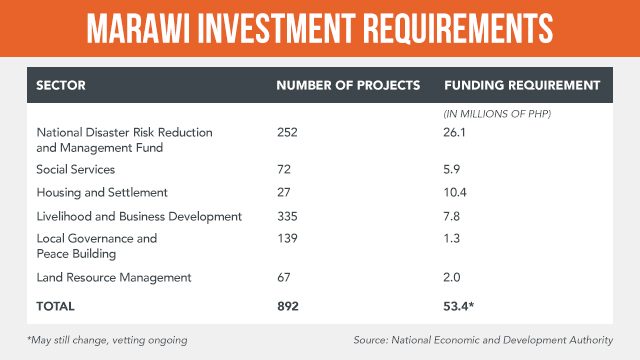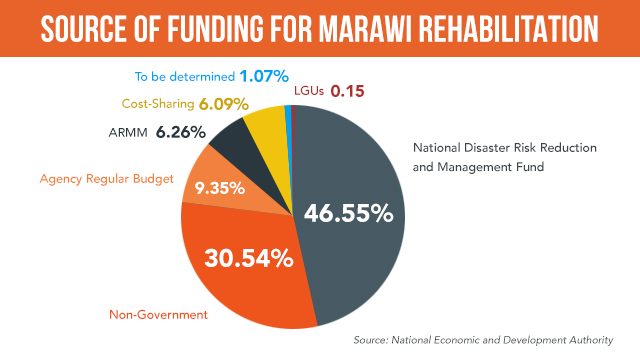SUMMARY
This is AI generated summarization, which may have errors. For context, always refer to the full article.

MANILA, Philippines – National Economic and Development Authority (NEDA) Secretary Ernesto Pernia said the rehabilitation program in war-torn Marawi City will not suffer the fate of areas destroyed by Super Typhoon Yolanda (Haiyan) back in 2013.
“We have learned our lessons in Yolanda and we are not going to repeat the problems. Building facilities with no services, no utilities, that really should not be done,” Pernia said in a press briefing on Monday, May 21.
Over P73 billion ($1.3 billion) is needed to finance the rehabilitation of Marawi City. Of this amount, around P17 to P20 billion ($324- 381 million) is needed to rebuild ground zero, while P53.4 billion ($1 billion) is needed to finance efforts in surrounding areas.
The government estimated that P26.2 billion ($500 million) is needed to be spent in 2018 for various rehabilitation efforts. So far, the government has raised only some P10 billion ($190 million).
For the succeeding years, from 2019 to 2022, P27.3 billion ($520 million) will be spent.
Despite being short of the intended budget for the year, Pernia is confident that the full amount can be raised.
“The leadership is determined to get Marawi back on its feet. There are commitments,” from the private sector and in the form of Official Development Assistance (ODA), Pernia said.
Undersecretary Adoracion Navarro said one upcoming source of financing is the planned issuance of up to P30 billion ($572 million) in “Marawi bonds.”
Investment requirements
The Marawi rehabilitation is focused on 6 major areas, namely, infrastructure, social services, housing and settlement, livelihood and business development, local governance and peace building, and land resource management.

Majority or P24.9 billion ($475 million) will come from the National Disaster Risk Reduction and Management Fund (NDRRMF). The rest of the funds will come from the private sector, the agency regular budget, the Autonomous Region in Muslim Mindanao, cost-sharing arrangements, and donations from local government units.
The government has yet to determine where to source P569 million ($10 million).

The government has received ODAs from China, Japan, and Australia.
China has given P1.23 billion ($23 million) worth of technical cooperation grant.
Japan has provided some P1.6 billion ($30.5 million) to rebuild roads and provided equipment and machinery.
Australia has provided some P926 million ($17 million) in humanitarian assistance.
Rebuilding ground zero
A separate rehabilitation plan was set by the government for the Most Affected Areas (MAAs) or ground zero. The Bangon Marawi Consortium was handpicked by the government to rebuild the area for P17.3 billion ($330 million). (READ: Tasks for China consortium in P17.2-B Marawi contract)
There was no bidding for the project, but their designs will be subjected to a Swiss challenge. (READ: Gov’t illustrations of Marawi rehabilitation plan)
“In our official meetings, the Swiss challenge will be on May 25, and groundbreaking is set on June 2018,” said Navarro.
The Swiss challenge has been delayed by 3 weeks. Task Force Bangon Marawi initially aimed for it to be conducted earlier this month, May 4.
Two Chinese companies in the consortium were once blacklisted by the World Bank over corrupt practices.
“I will have to direct that question to Task Force Bangon Marawi, but NEDA researched these two chinese firms and we learned that [the ban] has been lifted in 2015, 2016,” Navarro said.
The project is slated to be finished before the end of the 4th quarter of 2021. – Rappler.com
*US$1 = P52.43
Add a comment
How does this make you feel?
There are no comments yet. Add your comment to start the conversation.